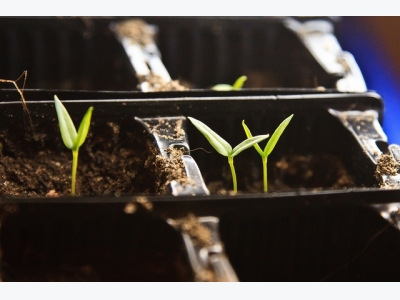Make Your Own Seed Capillary Mat: Self Watering Trays

CC flickr photo by oherrala
Once you’ve planted your seeds indoors, they need just the right amount of water to germinate and mature. Capillary mats, also called self watering trays, are a great watering option. Without a steady supply of water, the results can be disastrous. Give your pots too much or too little water and seeds can fail to germinate, plants can die, or they can fail to reach their full potential. For first-time gardeners, the tendency is to overwater and drown plants, or alternately, forget to water altogether.
BENEFITS OF SEED CAPILLARY MATS
Capillary mats are a surefire way of providing a steady, adequate supply of water to germinating seeds and seedlings. A capillary mat is a mat made of felt (or other absorbent fabric) upon which potted seedlings sit. The mat absorbs water from a reservoir and the pots are able to draw a steady supply of water from it, absorbing the exact amount they need, when they need it.
Essentially, it is a wicking process, whereby the mat wicks water and then the soil in the pot wicks the water from the mat. Capillary mats are traditionally used in greenhouses or with hydroponic systems, but they are now widely used by home gardeners as well.
Benefits of capillary mats are numerous. The obvious benefit is convenience — all you have to do is fill the water reservoir once or twice a week and the plants get exactly what they need, when they need it. According to a University of Arizona study, capillary mats also save on water — up to 71 percent less in summer and 62 percent less in winter — compared to hand watering. The researchers also found that some plant species using capillary mats grew more robustly, producing a bigger canopy. Using capillary mats tends to make plants grow deeper roots, because they have to reach to absorb water from down below.
HOW TO MAKE A SELF WATERING TRAY: SUPPLIES NEEDED
You can purchase capillary mats from your local garden supply store or you can make one yourself, using a few on-hand supplies and a little bit of know-how.
Items Needed
- Plastic tray
- 1-inch-thick piece of Styrofoam
- Scissors or utility knife
- Wool blanket, sweater or scarf
- Nails or thumbtacks
- Pots or seed trays with drainage holes in the bottom
- Water
BUILDING THE SELF WATERING TRAY
- Cut Styrofoam to fit inside plastic tray, with about 1 inch on all sides to spare.
- Cut wool to fit Styrofoam but leave the wool long enough on two ends to hang down under so it can absorb the water.
- Use nails or tacks to fasten the wool to the Styrofoam.
- Place wool-covered Styrofoam in the tray, wool side up.
- Fill the tray with water, making sure that the blanket is saturated without being totally submersed in the water. The wool will absorb the water as needed, provided it is hanging down on the ends and touching the water.
- Place pots and/or seed trays on top of wool-covered Styrofoam and let them absorb the proper amount of water.
TIPS FOR USING SEED CAPILLARY MATS
- You can use capillary mats effectively with peat pots, soil blocks or pots and trays with holes in the bottom. You can even use a variety of containers on top of one capillary mat.
- Monitor your plants to gauge how often you have to fill the tray. It could be anywhere from several days to one week between waterings.
- Make sure that at no point the plant pots are submerged in standing water, as this will cause mold and rot, and could weaken or kill the plant.
- We have recommended wool as matting material, but in fact any absorbent material will work, including cotton and felt purchased from your local fabric store. If you are growing plants for food, be sure to select a nontoxic material and avoid strong detergent or fabric softener residue.
- Always monitor for any signs of mold or bacteria, as this can cause growth problems or even kill your young plants.
Related news
 What You Need to Know About the Bee Balm Plant
What You Need to Know About the Bee Balm Plant Bee balm, which is also known as Oswego tea, horsemint and bergamot, is a versatile perennial plant that can add color and beauty to any garden.
 15 of the Best Common Organic Fertilizers
15 of the Best Common Organic Fertilizers Understanding the common organic fertilizers available is as simple as knowing what each offers your soil and how “available” (easily accessed) those offerings
 A Beginner's Guide to Hydroponics
A Beginner's Guide to Hydroponics The first step to setting up your first hydroponic garden is selecting a system that best fits your needs.